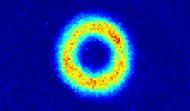Feb 16 2011
Physicists at the Joint Quantum Institute, University of Maryland, have built a circuit that is hardly more than a whiff of gas moving within laser beams.
The team has endeavored to make the particles in the cold gas flow in the form of a current, monitoring it and switching it on and off, thus moving a step further towards developing an atomtronic device.
 JQI's Spinning ring
JQI's Spinning ring
Atomtronics is a theoretical field that is founded on the theory that atoms in quantum forms of matter may offer an option for constructing devices. Scientists have drafted blueprints for atomic kinds of electronic parts ranging from wires and batteries to transistors and diodes.
Anand Ramanathan at the institute and his fellow students will deploy an ultra cold gas called Bose-Einstein condensate to help them create atomtronic sensors. They are publishing their research report in Physical Review Letters, wherein they explain how they produced this gas by bringing down the temperature of sodium atoms that were floating in magnetic fields. The atoms were then captured within two crossed laser beams. The atoms were chilled even more to less than 10billionths of a degree above zero. The condensate that was created at these low temperatures was shaped by the laser beams into a flat ring that had a radius of approximately 20micrometers.
This theory was inspired by superconducting quantum intrusion devices, or SQUIDs. These devices display extremely weak magnetic fields by tracking sudden current changes in semiconductor loops. Campbell’s team says that the Bose-Einstein condensate could offer a highly sensitive spinning sensor. They incorporated a weak link to the condensate ring like a barrier being formed by a blue laser that could accelerate or stop the flow. If the condensate was to be kept inert and the barrier linked to a spinning sensor, the barrier would make the current jump involuntarily at specific spinning speeds.